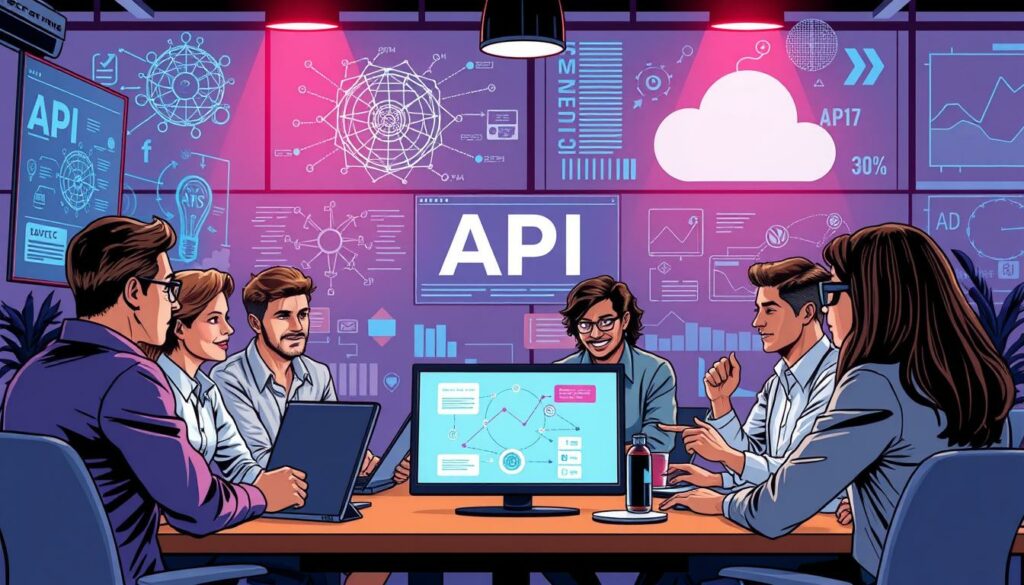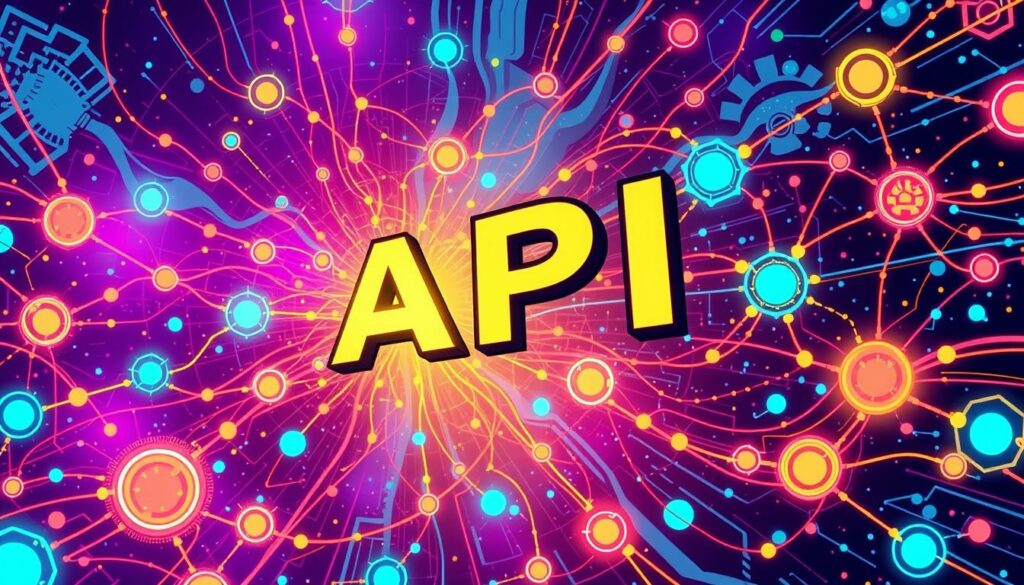Did you know that about 85% of web apps today use APIs? These APIs are key for apps to talk and work well. They’ve evolved from simple links to complex systems that make things work better, safer, and easier.
APIs, or Application Programming Interfaces, have changed a lot over time. They’ve grown from simple tools to advanced systems. This journey shows how APIs have become essential in software development today.
Key Takeaways
- The reliance on APIs in web applications highlights their fundamental role in software interaction.
- API transformations have significantly advanced the functionality of software ecosystems.
- Understanding the history of APIs provides insight into their current capabilities.
- Modern API design emphasizes usability and security, adapting to new technological trends.
- APIs have catalyzed innovation across various sectors, demonstrating their versatility.
Introduction to APIs
Understanding what is an API is key to modern software development. APIs, or Application Programming Interfaces, act as bridges. They let different software apps talk to each other smoothly. They set rules for how apps can share data safely.
The API definition talks about how different software parts can work together. APIs help apps get data from servers or share features. They make sure everything runs smoothly, improving how users interact with apps. APIs are vital, affecting everything from web services to mobile apps.
For developers, learning about APIs is crucial. It helps create better apps. Using APIs makes it easier to add new features, saving time and making apps grow. You can find more info online, like about natural language processing, which uses APIs.
Understanding the Basics of API Design
Effective API design principles are key to making APIs easy to use, secure, and maintain. When developers create APIs, making them user-friendly is crucial. A well-designed API makes it easier for developers to use and integrate it into their apps.
The structure and clarity of API architecture are essential. Good documentation helps users understand how to use the API. This reduces confusion and makes it easier for developers to use the API as intended.

Using frameworks like REST and GraphQL is a solid start for designing APIs. These frameworks have benefits for different users. For example, Deno 2.0 supports frameworks like Angular and Next.js, showing how modern APIs can work well together.
APIs are always getting better, like the Angular team’s updates to their effect() API. This shows the value of listening to developer feedback while keeping up with best practices in API design principles. Check out a recent article for more on these updates and how good API architecture leads to success in different programming settings. Learn more here.
Historical Context: The API Development History
The history of API development started in the 1960s with subroutines and libraries. These early steps helped software components talk to each other. The 1970s and 1980s brought modular programming, making interactions more standard.
Remote Procedure Calls (RPC) emerged in this time, enabling machines to communicate easily. This was a big step forward in API history.
In the late 1990s, SOAP-based APIs made exchanging information online better. This was a key time for APIs, as they became essential for web technologies. The early 2000s saw public APIs become common, with Salesforce leading the way in 2000.
RESTful APIs then made web app communication simpler. This made APIs easier for developers to use.
The 2000s also saw cloud computing change how APIs were used. AWS, Google Cloud, and Microsoft Azure made their APIs available. This allowed developers to work with cloud services more efficiently.
The 2010s brought microservices architecture, making apps more scalable. This led to many APIs being created for specific tasks. GraphQL, introduced by Facebook in 2015, made APIs more flexible and efficient.
Today, companies like Stripe and Slack use APIs to build strong business models. AI and machine learning APIs, like Google’s TensorFlow, are also advancing rapidly.
Looking forward, trends like serverless architectures and API-first approaches are shaping API development. Knowing API history helps us understand the journey and look forward to future innovations.
Evolution of APIs
API development has seen big changes over time. These changes meet the needs of programmers and businesses. Knowing the API evolution timeline helps us see how system communication has changed.
From RPC to REST: A Timeline of Change
The journey started with RPC (Remote Procedure Call). It let programs call procedures on a remote server. But, it had limits in compatibility and scalability.
The arrival of REST APIs (Representational State Transfer) was a big change. REST is known for its stateless design and focus on resources. It’s lightweight, making it scalable and easy to use. This makes API integration better for developers.
| API Type | Advantages | Disadvantages |
|---|---|---|
| RPC |
|
|
| REST |
|
|
Introduction of GraphQL and Its Impact
GraphQL API brings a new view on API design. Unlike REST, GraphQL lets clients ask for specific data. This reduces over-fetching and makes data retrieval more efficient.
The debate of GraphQL vs REST shows GraphQL’s big impact. It changes how developers design their apps.
GraphQL makes data management better and improves the developer experience. It makes APIs easier to use. As companies adopt new methods, knowing about different APIs is key to using their systems well.
API Technology Advancements Over the Years
The world of API development has changed a lot, thanks to cloud computing and microservices. These changes have made it easier for developers to connect applications and make services available. Knowing about these changes helps you understand modern API practices better.
How Cloud Computing Started the API Revolution
Cloud computing APIs have been key in changing API technology. When companies moved to the cloud, they needed apps to work smoothly together. Big names like AWS, Google Cloud, and Microsoft Azure created strong frameworks for cloud API development.
These APIs make it easy to scale apps. This lets developers spend more time on new ideas and less on managing tech.
Switching to a distributed architecture has sped up app development. It also made teams rely more on automation and efficiency. Cloud services support many programming languages and protocols, helping teams work better together.
Microservices Architecture and Its Influence on API Development
Microservices architecture has changed how APIs are built and used. It breaks apps into smaller services, each with its own API. This makes apps more flexible and scalable.
Teams can update services without affecting the whole app. This reduces downtime and makes apps more reliable.
Using microservices has made apps better and faster. APIs can now be designed for specific tasks. This means updates and growth happen smoothly without problems.
By using cloud computing APIs and microservices, apps become better and more ready for the future. This shows a move towards a more connected and efficient digital world.
Modern APIs: Features and Functionality
APIs have changed a lot, bringing new features that improve how they work, feel, and stay safe. Knowing what makes modern APIs special is key for companies wanting to succeed today.
Key Characteristics of Sophisticated APIs
Modern APIs have some key traits that show how advanced and useful they are. These traits help them work better and serve their purpose in software making. Some important ones are:
- Scalability: Modern APIs can handle more work without slowing down, which is great for apps that grow.
- Reliability: They have smart ways to deal with problems and keep things running smoothly.
- Security: They use strong security to keep data safe during transactions.
- Excellent Documentation: They have detailed guides and examples to help developers use them easily.

Security Innovations in API Development
APIs are more important than ever, so keeping them safe is a big deal. Companies need to use the latest security methods to keep data safe and stop unauthorized access. New security ideas for APIs include:
- OAuth: This system makes sure only the right people can access data.
- API Gateways: These are like secure doors for API requests, adding an extra layer of protection.
- Rate Limiting: This helps control how many requests an API gets, stopping abuse and keeping services running.
Knowing the risks of APIs and using good security helps developers and companies keep their apps safe. Focusing on making APIs better also makes them safer in our complex digital world.
Trends and Innovations Shaping API Evolution
Technology is moving fast, and keeping up with API trends is key for developers and businesses. Now, APIs are being used more in companies to make things run smoother and improve how users interact with them. Low-code and no-code platforms are becoming popular, showing a big innovation in APIs. They let teams without much coding skill build complex apps quickly.
More public and private API marketplaces are popping up. This gives businesses a chance to make money and developers an easier way to find what they need. These places help people work together, sharing resources and making the future of APIs stronger for many apps.
Knowing about these changes helps create smarter solutions. These solutions meet today’s needs and look ahead to tomorrow’s. In a competitive world, using these innovations can really help your organization grow and stay flexible.
Looking at how technology and what people want are changing helps professionals find the best ways to use API trends. It’s also important for companies to think about security and reliability. This builds trust and makes the most of these API innovations.
To learn more about how technology is changing things for the better, check out this insightful resource.
The API Transformation Journey in Various Industries
APIs have changed many sectors, making operations better and customer experiences richer. Seeing how different businesses use technology to innovate is fascinating. With industry-specific APIs, companies make their processes smoother and offer better services.
Case Studies of Successful API Implementations
Many API transformation case studies show how APIs have made a big difference. Here are some examples:
| Industry | API Use Case | Outcomes |
|---|---|---|
| Finance | Payment Processing APIs | Increased transaction speeds, improved fraud detection, enhanced security. |
| Healthcare | Telehealth APIs | Expanded patient access, streamlined scheduling, improved care coordination. |
| E-commerce | Inventory Management APIs | Real-time stock tracking, reduced overhead costs, enhanced customer satisfaction. |
| Event Management | Face Recognition APIs | Faster check-ins, enhanced security, improved event flow. |
These examples show how APIs make things run better. For example, in event management, AI and face recognition have changed how people get in. It’s faster and safer, making events run smoothly.
Challenges and Opportunities in API Development
Creating effective APIs comes with many chances but also faces several challenges. It’s key to know the pitfalls in API development to make high-quality integrations. Common mistakes in API design can hurt usability, scalability, and performance.
Common Pitfalls to Avoid in API Design
When starting API development, avoiding certain API design mistakes is crucial. This can make your APIs more efficient and popular. Here are some major pitfalls to watch out for:
- Lack of Documentation: Bad or unclear documentation can confuse and upset developers. Good guides help users use your API well.
- Poor Versioning Practices: Not having a good versioning plan can break integrations and upset users. Use clear versioning and tell users about changes.
- Neglecting User Feedback: Not listening to user feedback limits improvement. Asking for and using feedback can make your API better and more relevant.
- Overcomplexity: Making APIs too complicated can make them hard to use. Aim for simplicity while keeping functionality strong.
| Pitfall | Impact | Mitigation Strategies |
|---|---|---|
| Lack of Documentation | Confusion and poor adoption | Provide comprehensive API docs and examples |
| Poor Versioning Practices | Disruptive updates and errors | Implement clear versioning and communicate changes |
| Neglecting User Feedback | Stagnant growth and relevance | Encourage and incorporate user insights regularly |
| Overcomplexity | Poor user experience | Simplify the API design while maintaining features |
By tackling these pitfalls in API development early, you can make better APIs that meet user needs. Using platforms like Deno can help by offering tools that make development easier. Learn more about Deno’s role in improving API development here.
Conclusion
The evolution of APIs has changed how technologies talk to each other in many fields. Looking back at the API evolution summary in this article, we see big changes. These changes are not just about tech; they’re about how we connect, secure, and make things more efficient online.
With updates like Windows 11 and new tools like Windhawk, the future of APIs looks bright. It’s full of chances for growth and improvement.
AI is also making APIs better, especially in event management. This shows how APIs can handle things faster and keep things safe. Using these advanced tools helps solve today’s problems and keeps risks low.
But, there will always be new challenges ahead. Knowing about these trends and innovations helps you stay ahead in the digital world.
When planning your API projects, remember to stay up-to-date and flexible. The last thoughts on APIs stress the importance of using them for change and innovation. Keep moving forward with API evolution and make your business better for the future.
FAQ
What are APIs and why are they important?
APIs, or Application Programming Interfaces, act as middlemen. They let different software apps talk to each other. They’re key in today’s tech world because they make apps work better together, making things more useful and secure.
How has the evolution of APIs impacted software development?
APIs have grown from simple tools to powerful drivers of new ideas. This change has made apps more flexible, safe, and easy to use. These changes are vital in today’s fast-paced tech world.
What are the key principles of effective API design?
Good API design focuses on being easy to use, secure, and easy to keep up. It’s important for APIs to be simple and well-explained. Using REST and GraphQL can help meet different needs and improve the experience for developers.
What historical developments are notable in the API landscape?
APIs have come a long way. They started with simple RPCs, then SOAP, REST, and JSON. Each step shows big tech leaps and changing user wants, shaping today’s APIs.
What is the difference between REST and GraphQL APIs?
REST APIs follow a set structure for getting data. GraphQL lets users ask for specific data, making it more flexible and efficient. This change marks a big shift in API design.
How have cloud technologies influenced API development?
Cloud computing has changed API development a lot. It offers strong platforms for building, deploying, and growing apps. Big cloud names like AWS, Google Cloud, and Microsoft Azure have APIs that boost innovation.
What are the modern features of sophisticated APIs?
Today’s APIs are all about being scalable, reliable, secure, and well-documented. These traits aim to boost app performance and user satisfaction. They help companies stay ahead in tech markets.
What trends are currently shaping API development?
Now, API development is all about integration, low-code tools, and API marketplaces. Keeping up with these trends is key for developers to meet new tech and user demands.
What challenges do developers face in API design?
Developers often struggle with poor documentation, bad versioning, and ignoring user feedback. Knowing these issues can help improve API quality. This ensures APIs meet changing needs and standards.
Source Links
- 1. Override and Mock Network Responses in DevTools
- 2. The Rise of Digital Platforms: Shaping the Future of Connection and Commerce
- 3. Large Language Models Overview: Natural Language Understanding with LLMs
- My Guide to Understanding Data Centre Architecture: Core Components Every IT Pro Should Know
- Wazuh Home Network Setup: A Step-by-Step Guide
- Quantum Computers Decrypting Blockchain: The Risks and Implications
- Wazuh: Enterprise-Grade Security for Your Business
- Wazuh for Beginners: A Comprehensive Guide




